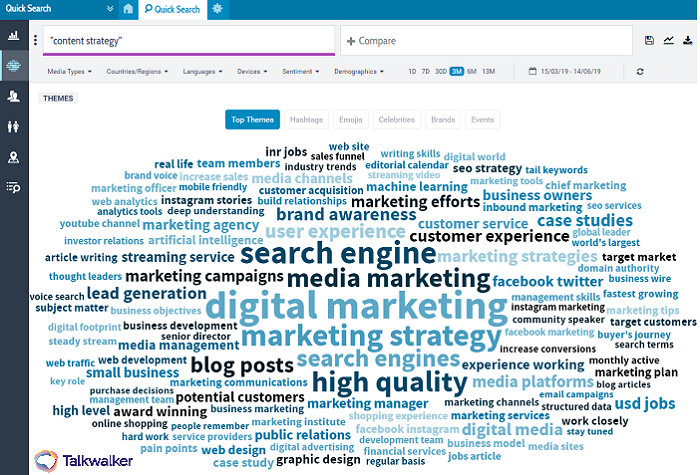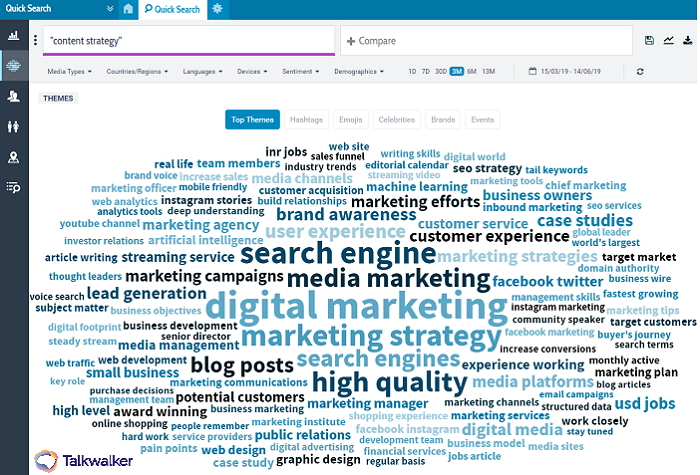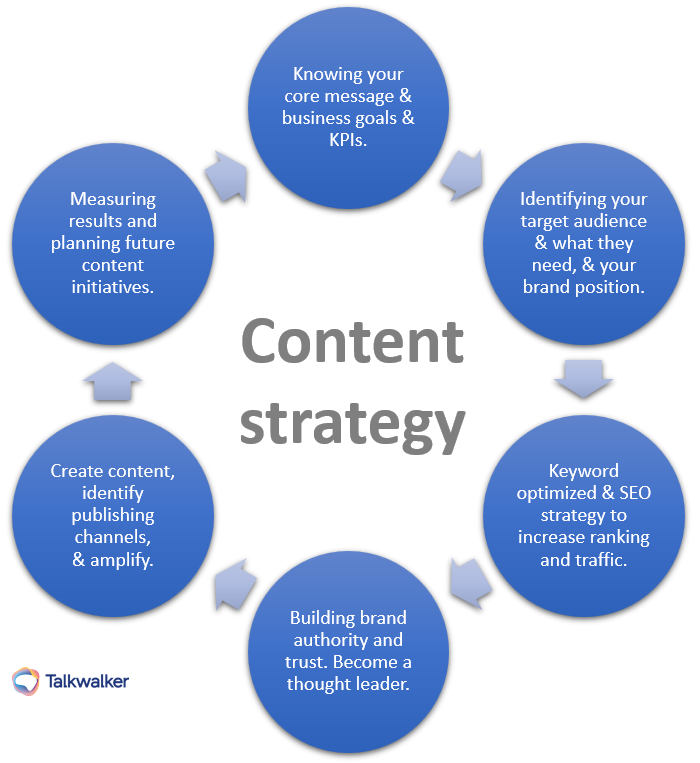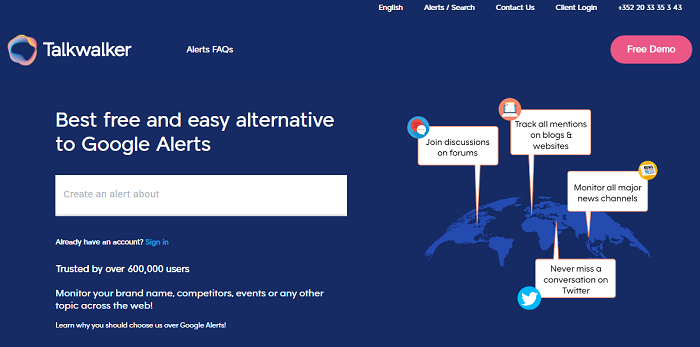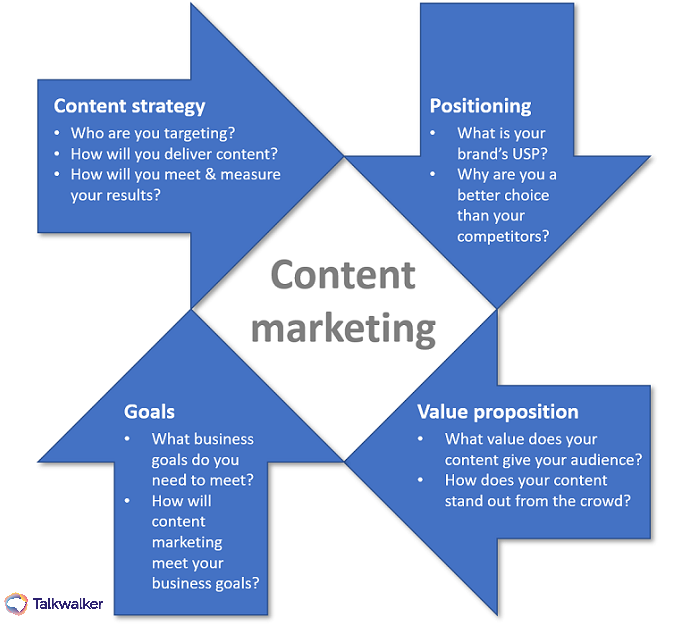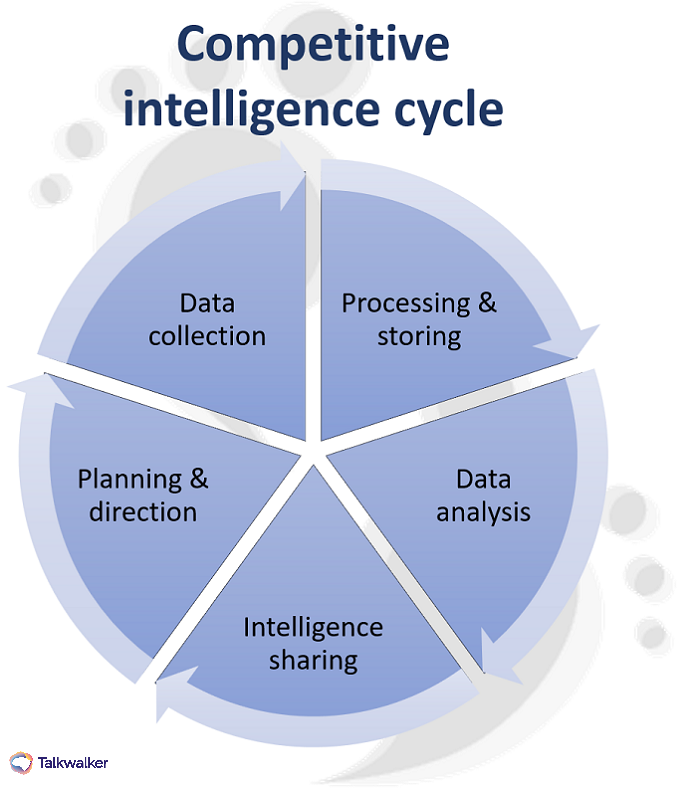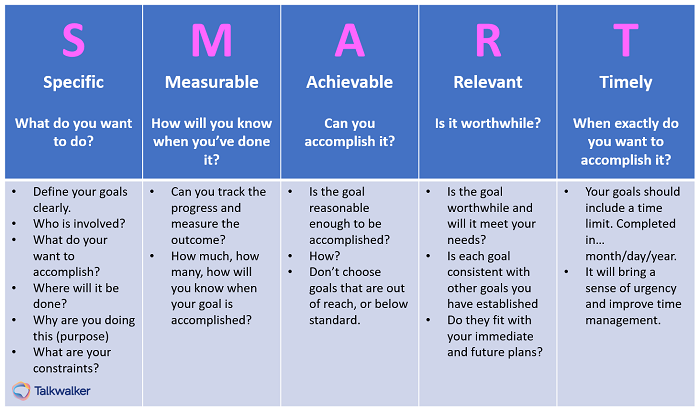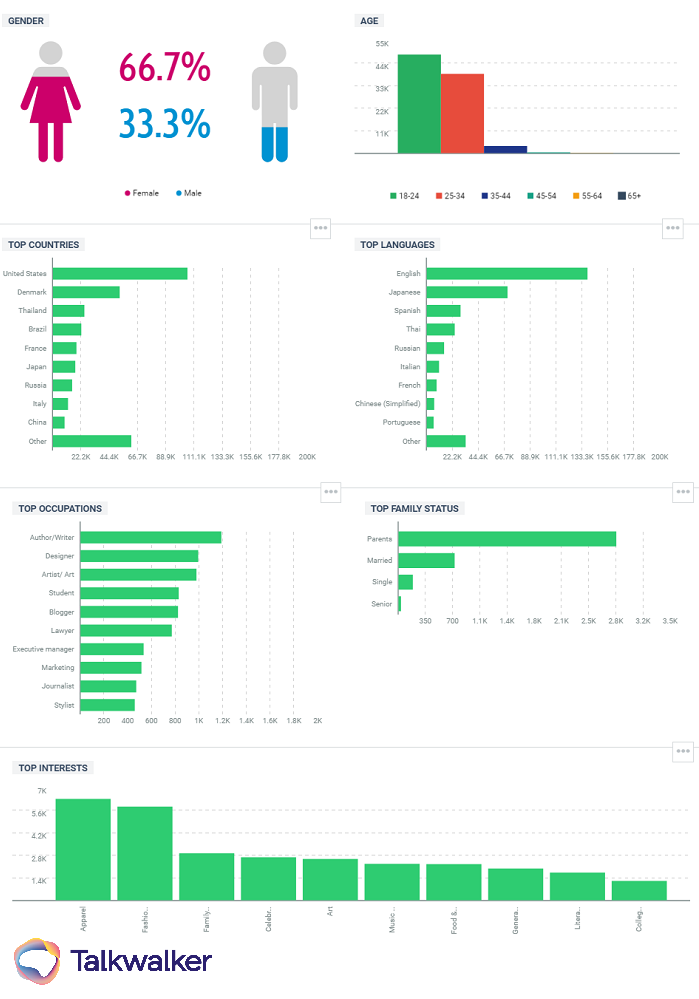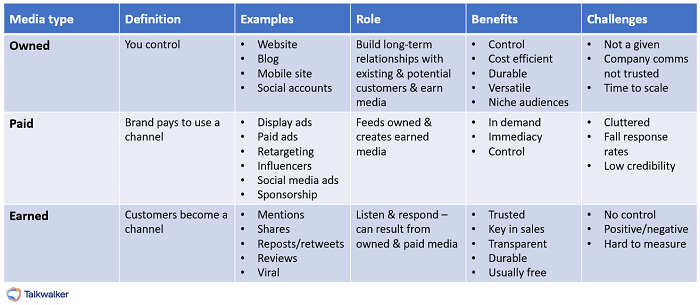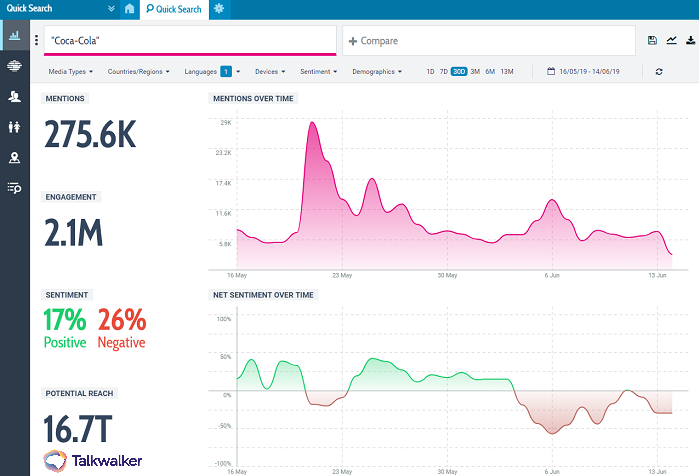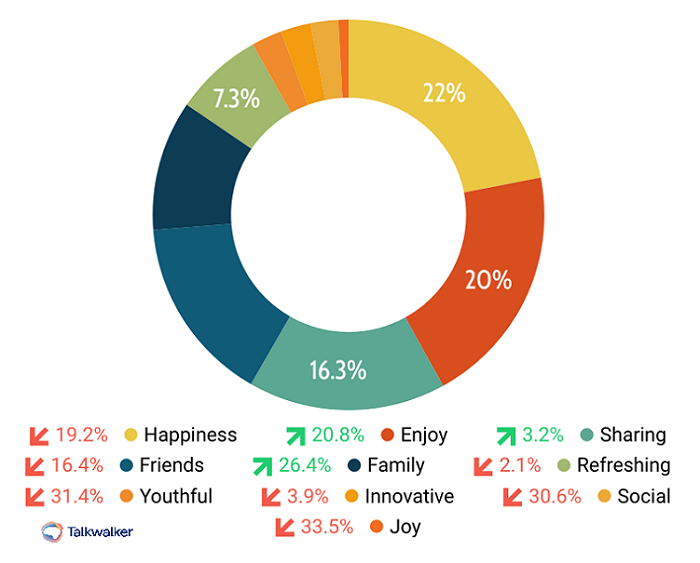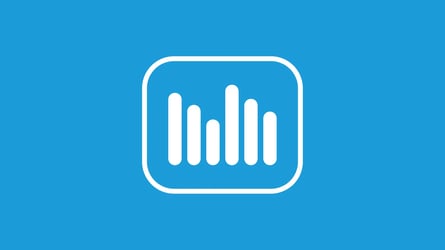I want my free content strategy template
Successful content strategies aren't nice things to have. They're a necessity. Download my Content Strategy Template to produce content that’s...
- Mission-specific
- Customer-centric
- Relevant
- Comprehensive
- Adaptable
Content strategy - touching every aspect of digital marketing. Quick Search data.
According to the Content Marketing Institute, 80% of B2B marketers say they have a content strategy, but only a third have it documented. Only 42% of B2B marketers report that they’re effective in their content marketing efforts.
Scary!
This content strategy guide is going to answer all your questions. There’s also a free content strategy template to download.
Let’s go...
Table of contents
- What is content marketing
- Why you need a content strategy
- Content strategy definition
- 6 reasons to create content
- 4 elements of a content strategy
- How to create a content strategy
- Free content strategy template
- Measure the metrics that matter
- 5 symptoms of content strategy failure
What is content marketing?
Content marketing is the process of attracting, engaging, and maintaining an audience - your consumers - by writing and sharing valuable and relevant content. In the form of blog posts, social media posts, videos, podcasts, etc. Your content marketing strategy's goal will be to establish your brand as an industry leader, increase your brand awareness, and ensure your brand is top of mind with consumers.
Why you need a content strategy
Your content team produces multiple types of content - videos, blog posts, social media messages, podcasts, press releases, white papers, etc. It needs a purpose. A goal. It must be planned. It must be managed. You need a content marketing strategy.
Or, do you throw everything at the wall, and see what sticks?
Good luck!
Before you even start writing content, you need a content plan.
Definition of a content strategy? The management of all the content you’re producing. Everything from your brand tone of voice, to how you’ll amplify and promote your content. Your objectives, your goals, your target audience, your outreach, and your repurposing plans.
Content strategy definition?
What is a content strategy? A content marketing plan that guides the creation, publication, promotion, and amplification of relevant, usable content. You and your content team will be able to define the process, timeline, and stakeholders. Coordinate, create, and distribute your content. Providing the right content to the right audience.
What is a content strategy?
- Defines how you’ll use content to meet your business goals, and boost user experience
- Guides decisions about content from creation, to repurpose, to deletion
- Sets benchmarks against which to measure the success of your content
6 reasons to create content
Huge, huge benefits!
I’m not just talking about blog posts. Your content calendar should include videos, white papers, customer case studies, quizzes, infographics, and more. You’re not creating content to fill in gaps, white space. You’re producing great content to meet previously determined goals. KPIs.
Here’s how content will benefit your business…
Keeps your website current/relevant
Your business has evolved over time. What was relevant two years ago, isn’t necessarily accurate or up-to-date. You’ve launched new products and features. Introduced new services. Rebranded. Your customer base has changed. Your tone of voice has grown up. All these, and more, changes should be reflected on your website.
I’m not suggesting you delete blog posts that are a couple of years old. Losing that valuable link juice, would be a crime. Update. Repurpose.
Keyword optimized for search
Launching a new product? Introducing a new service? Do keyword research with a tool such as Semrush or Ahrefs, and create content that'll not only inform users, but help them to find you in search engines. Don’t forget to use long-tail keywords - they account for the majority of web searches.
Use Google Analytics and Talkwalker Alerts to monitor target keywords in your industry. If you find one that relates to your business, provide content around it.
Use Talkwalker Alerts to monitor keywords and phrases in your industry.
You want users to find you. Stop hiding!
SEO content marketing
We don’t know how Google determines page ranking. The specifics of the search algorithm are locked in a vault snuggled up next to the formula for Coca-Cola and KFC’s 11 herbs and spices.
Thankfully, there are experts who - after much research - have determined some of the 200+ ranking factors. When working on search engine optimization, consider the following factors...
- New content and pages added regularly - according to Moz, Google measures content for freshness - inception date, updated vs static content, frequency of changes, new pages, etc - then scores
- Unique, relevant, up to date content
- Optimized content - a keyword for each piece of content/web page
- Internal linking to new content
- Backlinks from high authority sites
- Optimized alt text and meta descriptions with keywords
Become a thought leader
High-quality content will increase your credibility. You’ll be considered an expert and your opinion will be sought.
Nice.
With increased authority, comes more site traffic, improved search engine ranking, and a bigger audience.
Even better.
Don’t restrict yourself to writing blog posts. Content includes infographics, slideshares, videos, podcasts, interviews, live streams, guest blogs.
Increase traffic to your website
More traffic => more leads => more customers.
Not sure I need to say more, other than… if you’re struggling with ideas for content, take Quick Search for a spin. You’ll be able to find awesome viral content ideas.
Quick Search - find viral content ideas and trends in real-time.
BTW - don’t forget user-generated content. 48% of consumers say that UGC is a great way to find new products. While website visitors spend 90% more time, UGC is featured. It’s an indicator of brand quality that’s trusted. Use it!
Planned or spontaneous, UGC is free, trusted, word-of-mouth advertising. Remember Starbucks’ #WhiteCupContest?
From every angle, beautiful.
Congrats to our #WhiteCupContest winner, @blynnxoxo! pic.twitter.com/A0ZRqJWWGr— Starbucks Coffee (@Starbucks) June 19, 2014
Customize your Starbucks’ cup. Photograph it.
Share it on social media hashtag #WhiteCupContest.
Over a three week period, close to 4000 people submitted entries. A UGC winner!
Check out How to get the most out of user-generated content - tips, tools, tactics.
Stay top-of-mind with customers and prospects
There are many ways to stay top-of-mind…
- Responsive and up-to-date website
- Active on social media - Facebook, Twitter, LinkedIn, Instagram, YouTube
- Newsletter and email campaigns
- Lots and lots and lots of content
Deliver problem-solving, educational content. What are end-users’ issues? Address their pain points, target their needs. Validate your existing customers’ decision to work with your product, and trust levels will increase. Churn will be reduced.
Prospects that are undecided, will keep you on their radar if they see you continually posting valuable content. Play your cards right, and you may win them over.
I'll Take My Free Content Strategy Templates
4 elements of a content strategy
Okay, we’re going to build you a content marketing strategy. To ensure it’s sustainable, we’ll start with the four areas that'll act as the foundation…
1. Brand positioning
2. Value proposition
3. Business goals
4. Content plan
Content marketing strategy.
1. Brand positioning
If your brand positioning is fluid, you won’t be able to give consumers a consistent experience. Your core message will waver. Your brand personality will change depending on which channel you’re promoting.
Define your position in your market…
- Who are your existing customers?
- Who are you targeting as future customers?
- What are your potential customers looking for?
- How are your competitors promoting their brands?
- What pain points does your product solve?
- What makes your product unique - better than the competition?
- How can you stand out in your industry?
Competitor analysis is too big a topic to cram in here. I’ve a Competitor analysis guide you can check out. It includes techniques, real-life examples, tools, and templates.
You’ll be shown how to compare your brand performance alongside your competition. Learn why they’re outranking you. How you can outsmart them. The data you’ll identify, will feed your marketing strategy, bringing new ideas and inspiring your marketing team.
Intelligence is info that’s been analyzed, with insights squeezed out to enable decision making, such as whether to discontinue a product or which audience segment to target.
2. Value proposition
Your owned media… what’s it worth?
I’m talking about the digital marketing channels that your business controls - coming from your website - blog posts, case studies, white papers, eBooks, social media messaging, etc.
-
What value does your content provide, that your competitors’ doesn’t?
-
What makes your content stand out from the crowd?
-
Why should consumers follow your content?
Listen to your audience. What are they looking for? What information do they need? Which social channels are they using? What languages are they speaking? Compare the results with the content you’re providing.
Do they match?
Check out our Essential guide to paid, earned, and owned media, for more information about PESO.
3. Business goals
Your content must provide value to your audience. And, drive your brand towards achieving your business goals. Fail to do this, and you’ve fallen at the first fence.
Establish the resources you’re going to need. The costs. The risks. How you’re going to achieve your goals, and by when. Be SMART!
4. Content plan
Your content plan has to focus on your business goals, and how you'll achieve them. Your plan will determine which audience you want to reach, delivery, and how you’re going to measure your results.
I'd Like Content Strategy Templates
How to create a content strategy
Let’s get down and dirty. It’s time to create your content strategy.
First up…
Core message
You need a clear and concise message that you send out to consumers. And, it must be consistent. Contradicting yourself from platform to platform, will confuse your audience.
This core message will unify all the content that you produce. So, although it’s different content - videos, podcasts, blog posts - it’s all coming from the same place. The same voice.
Determine your goals and KPIs
Start with measurable objectives. Clear goals. Remember SMART?
Wanting to increase conversions is good, but by how much? Within what time period? Make your objectives SMART, so they can be measured. So you can prove you met or surpassed them.
SMART goals- specific, measurable, achievable, relevant, timely.
- Specific - real numbers with real deadlines - who, what, where, why?
- Measurable - how will you track and analyze each achievement?
- Achievable - choose goals that are challenging, but possible.
- Relevant - check you have the resources to achieve your goals.
- Timely - when do you intend achieving your goal?
Here are some examples of SMART goals…
- Increase blog subscribers by 60% by Q4
- Achieve average email click through rate of 15% by October
- Increase LinkedIn followers to 550K by Q3
- Grow website visitors to 3,000 per month by September
It’s vital you understand your current position, so you can set realistic and achievable goals. Once they’re agreed, every piece of content your team produces should be aligned with your goals.
Audit your existing content
There are over 70 million blog posts published each month. 70 MILLION!!!
How will you stand out from that crowd? How will you ensure that consumers click your content?
If you don’t know what’s firing up your audience, you don’t know what’s making your brand go pop. How will you know what to create?
You need to monitor and analyze the results your content’s bringing. Which of your posts have the highest engagement. What email brought the best click through and open rate? Which video was shared most?
Who are you creating content for?
You might have a team of awesome content strategists. Churning out finely-crafted blog posts, rocking videos, insightful social messages. But… who’s their target audience? Do you have several audiences, with differing needs?
Talkwalker Analytics - audience demographic.
Ensure your content marketing strategy can target more than one type of audience. One segment is big into video and Instagram, while another is heavily invested in posts on LinkedIn. Consider all your customers as individuals and as segments. Which social channel is segment A on? Does segment B prefer videos, podcasts, or case studies?
What do consumers want?
You won’t know this if you don’t collect consumer insights. Don’t think for a moment you can guess what they want. That kind of shortsightedness has destroyed many a brand.
You have to monitor online conversations to identify consumer pain points, sentiment towards your products and brand. Plus, what they’re saying about your competitors and your industry.
The best ice cream on earth. pic.twitter.com/05Dz5DnU3u
— Jonathan (@jpboogie2381) March 9, 2019
No brand mention.
Talkwalker’s image and video analytics tool hunts down all visual mentions.
Brand named, or not.
Ideally, your product solves a problem that your audience has. Your content has to educate consumers to solve any issues they’re experiencing. It has to provide value. Make their lives easier.
Your content strategy has to support not only consumers that are still coming to terms with your products, but those who are implementing your product successfully.
Give your audience the right content, and you’ll make them experts in your product. Play your cards right and you could earn some cracking user-generated content.
Awesome user-generated content, undetected without visual analytics.
I can’t tell you what this content should be for you brand. It differs from industry to industry. You have to listen.
Content formats you can offer
What content are you going to produce? Blog posts? Videos? White papers?
Once you’ve clarified the topics you’re going to cover, you’ll need to determine your resources and budget.
Here’s a listicle of content forms that you could work with - in no particular order...
Blog posts
Publish regularly, to attract new visitors. The content should provide value to readers, whether customers or prospects. Your blog posts should be so awesome, that readers share them on their social media accounts.
eBooks
Offer a free eBook, and you’ll get a download. None of us can resist a freebie.
EBooks belong in your inbound marketing process. After reading your blog post, offer an eBook that digs deeper into the topic.
For instance… I wrote a blog post - From Marketing Strategy to Marketing Plan. It explains the what, why, and how of creating a marketing strategy for your brand. The CTA in the post is to download a Free eBook: Digital Marketing Strategy Guide. The eBook - 13,000 words - includes the original blog post, campaign management formula, how to manage a social media campaign using social media listening, and social media reporting.
Case studies/testimonials
A customer used your product and solved all their challenges. Tell everyone.
Choose your form, it doesn’t have to be written content. You could create a podcast, infographic, video interview. The purpose of a case study is to show prospects, who are dithering about whether to work with your brand, that your product is awesome.
Remember, we love and trust user-generated content. 66% of consumers trust customer reviews 12x more than brand content. Spending 90% more time, if you feature UGC on your website.
Templates
Everyone loves a template. They’ll generate leads for your business, while providing value for your audience.
Give them something that saves them time and makes their job easier, and they’ll come back for more.
Infographics
They’re all over social media. Why? Cos we love to share them. An ideal way to organize a lot of data in a visually appealing way.
Video
By 2021, online traffic will be 80% video! It’s a form of content that brings high engagement, and is shared across social media channels and websites.
Costing more than a blog post, the high ROI justifies this expenditure. Marketers claim to get 66% more qualified leads per year if they include video marketing in their content plan. With brand awareness increasing by 54%.
If you’re going to go the video route, invest in a video analytics tool to accurately report ROI. With the right tool, you’ll catch user-generated content, trademark infringement, and you’ll be able to prove the ROI of your sponsorships.
For instance, your company has sponsored a football game. Visual analytics will capture your logo on the players’ and fans’ shirts, banners at pitch-side, etc. You’ll even find all those visual mentions from the crowd who shared videos of the event on social media.
Video analytics - played to perfection.
To accurately measure the impact of your sponsorship, you need to find every time it appears, with or without a text mention of your brand.
Social media
Please don’t tell me your business isn’t using social media...
You should be regularly sharing your content on your social media channels - Twitter, Facebook, LinkedIn, Instagram, YouTube...
Why?
Because that’s where the vast majority of the population are spending most of their time. Instagram users are looking for photos, videos, and graphics - current events, user-generated content, behind the scenes videos. On Facebook, users are reading blog posts, native Facebook videos, product promotions, memes, GIFs, event sign-ups.
Need some help? Follow these 23 social media tips, and rock your social strategy.
Posting on Facebook and Twitter will expand your audience and drive traffic to your website, and spark conversations in your industry.
Where’s your audience?
Here are some more content examples you can create...
- Email newsletter - weekly, monthly, quarterly - industry, company, product news
- Illustrations, cartoons
- Tool/product reviews
- Webinars - interviews, Q&As, product launch
- Giveaways - contests, quizzes
- Guides, manuals - videos, blog posts
- Opinion posts - customer, influencer
- Dictionary, glossary - definitions, terms
- Interviews - video, blog posts, podcasts - customers, CEO, influencers
- Listicles - top 100 Instagram influencers, Facebook stats, 50 best social listening tools, predictions
- Vlog
- Original research
- Press releases
- User-generated content - blog posts, social messages, reviews
- Podcasts
- Videos - interviews, HR recruitment, behind the scenes with the team, how tos
- Surveys, polls, quizzes
- White papers, reports - gated content
- Slideshares
- Content curation
- FAQs
Woah! Long list.
Which channels to publish on
A heap of different content forms, you’ve also got different channels you can publish on. These can include owned properties - your website, blog, social media. Earned and paid.
Check out our Essential Guide | Paid vs earned vs owned media, for more details on the differences between each type of media.
Owned, paid, earned media offer several options for publishing.
Content creation
Goals sorted.
Time to create your content. Depending on the content you’re planning to produce, assign your team members. Remember - and this is important - your team of content writers each have their own voice. They have individual personas, whether they’re writing blog posts, making videos, designing infographics.
Consumers have had their fill of corporate voices. Brand speak. Let your content team be themselves. Unique personas are remembered.
Consider the latest design trends when creating content. You need to be on-brand, but that doesn't mean your content can't be cutting edge design too.
Content amplification
Create. Publish. Amplify.
Marketing your marketing. Social media is the obvious go to for amplification. Share on your business and personal accounts.
Widen your audience and reach out to customers, employees, influencers, etc. to promote your content.
Content strategy template
It takes time, organization, data, and creativity to develop a successful content strategy. From building your marketing plan, to finding the best content marketing tools, managing your content, to putting your strategy in motion, to measuring ROI.
Got me some stats to share with you…
- Buyers view at least 13 pieces of content before making a buying decision
- 74% of companies find that lead quality and quantity increased when they introduced a content marketing strategy
- 82% of customers have a more positive outlook on a company after reading custom content
- Content marketing costs 62% less than traditional marketing
Looking to maximize the impact of your content and target the right, the best audience? Download my content strategy template, now!
BTW - It’s four templates in one. BARGAIN!!!
- Marketing KPI checklist
- Buyer persona template
- Project template
- Content strategy worksheet
Download now...
Free Content Strategy Templates
Measure the metrics that matter
And they are?
They’re determined by your goals and KPIs, and it’s the behavior of users in your marketing funnel...
- Viewership
- Engagement
- Lead generation
- Sales
Viewership
Early in the marketing funnel, this is where you’re touching consumers for the first time. Or, re-engaging. The data you collect will help you understand how much of your content was seen by the right people.
Engagement
Moving further along the funnel, engagement metrics reveal which of your marketing messages were viewed, and the actions that were taken by users. The level of engagement is important, what viewers did after they saw your content. Positive - shared. Negative - posted a bad review. Sentiment, good or bad?
Quick Search of Coca-Cola over a 30 day period.
Using Quick Search - social media search engine - we can see that engagement of the previous 30 days has been at 2.1M. But, sentiment has taken a nose-dive. The brand should dig deeper and find the cause.
The culprit.
An article was published in The Guardian revealing undercover footage of young dairy calves being kicked at a Coca-Cola affiliated dairy farm in Illinois.
BREAKING! America's largest dairy busted for severe animal abuse to baby calves. They supply to Coca-Cola's Fairlife brand. The undercover video is sickening. *Trigger warning* https://t.co/99Q8JdLZof
— Ari Solomon (@VeganAri) June 6, 2019
Hitting social media, sentiment started to drop.
The brand, while not publishing the negative content, should address this PR crisis with a response on social media, and mitigating content.
Take Your Free Crisis Management Templates
To help you deal with a PR crisis, download two free crisis management templates.
The roadmap to follow if a crisis strikes, and a checklist in case of emergency.
Lead generation
These guys are most likely to convert into a lead because they’ve demonstrated repeated interactions with your brand messaging. Subscribed to your newsletter. Signed up for a demo. Requested more information. Your content has grabbed attention and given value.
They’ve bothered. They’re interested.
Sales
These are the superstars! These metrics help your marketing team understand which actions brought revenue to your business.
How a prospect has traveled through your inbound marketing funnel. From initial exposure, to conversion from a lead to a customer. You’ll determine the most efficient and profitable route through your funnel, so you can continue to improve and generate more sales.
5 symptoms of content strategy failure
Content strategies don’t last forever. Goals change, audiences evolve, new products are launched. If you want to stay on top of your game, Regularly conduct a content audit.
What indicates an update is needed? Take a look…
Numbers are dropping
- No action on social media – no shares, new followers, engagement
- Page views are dropping
- Revenue is dropping
- Time spent on site is reduced
- Conversions are non existent
Basically, everything is dropping off...
Find what’s working and what’s failing.
- Repurpose or redirect failures
- Plan new content that replicates successful content
Social media content is ignored
Follower growth is static. Engagement is dropping off.
No one likes you… sad!
- Are you on the social channel that your target audience is using?
- Is your tone of voice, channel appropriate?
- Are you posting appropriate content for each channel?
If your target audience is on Instagram and Snapchat, posting long-form articles on LinkedIn is a nonstarter. Posting videos on Twitter is never going to work as well as YouTube. Talking ‘street’ on LinkedIn won’t win you any besties.
Search results are poor
Last week you were ranking page one, position 4. Good stuff! Today, you’re page two, position 9. Ouch!
Time to check your SEO strategy.
- Are you missing keywords that consumers are using?
- Has there been an update to a search engine algorithm?
- How is your website performing – responsiveness, loading time, navigation?
Analyze your website and published content.
- Monitor consumers online conversations with social listening to find the keywords, issues, and trends that they’re using in searches, and could impact your business.
- Check out the keywords that your competitors are ranking for.
- Refresh content to comply with algorithm updates
Soft drinks brand monitoring conversations about sugar and diabetes to find any potential crisis, trends, keywords.
Visitors aren’t converting
Visitors are landing on your site, but they’re quickly bouncing away. Your conversion rate has dropped.
Strip your content down to the bare bones. Is it too techie, full of industry acronyms and terms? Are you over-estimating the technical knowledge of your audience?
- Don’t dumb-down your content - make it accessible to everyone
- Develop a more user-friendly experience so visitors can easily navigate your site and find what they’re looking for
Too much brand speak
Forget your audience, lose your audience.
Your content – articles and website – is stuffed with keywords. Your messages are embarrassingly self-promotional. If consumers don’t get value from your content, they’ll soon find your competitors’ content more helpful.
Prove that you're experts in your industry and win back trust…
- Publish white papers, reports, how to videos
- Share customer case studies to demonstrate the efficiency and success of your product
These are tell-tale signs that something’s wrong. Ensure that you regularly monitor for any indication that results are dropping.
If something isn’t working… fix it!
Social Media Trends 2022
Every year, we create our Social Media Trends report. It involves speaking with a multitude of PR and marketing experts, digging into our client database of global brands, and performing deep analysis with our consumer intelligence platform. After an intense couple of months, we present our report that includes the top 10 social media trends to come, advice from international companies, industry leaders, and analysts, and examples of brands that are already exploiting the trends and creating exceptional marketing campaigns.
If you'd like to read our Social Media Trends 2022 report, you can download by clicking below. Seriously. It's going to help you create a solid content strategy...

